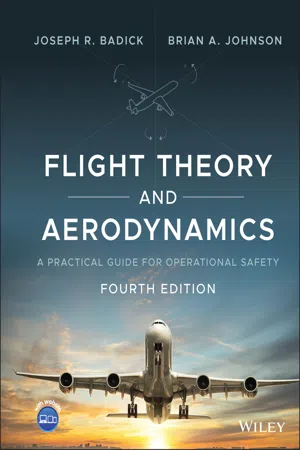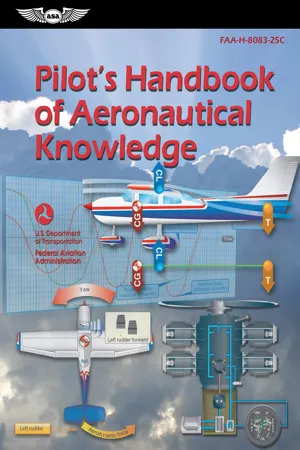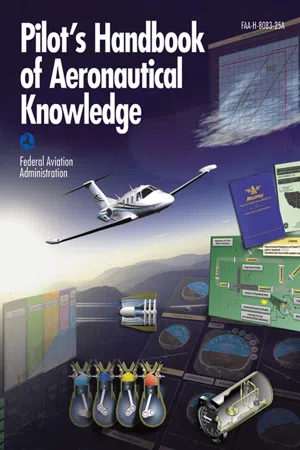Technology & Engineering
Lift Force
Lift force is the aerodynamic force that enables an aircraft to overcome gravity and stay airborne. It is generated by the interaction between the aircraft's wings and the air, creating a pressure difference that results in an upward force. Lift force is essential for flight and is a fundamental concept in aerodynamics and aircraft design.
Written by Perlego with AI-assistance
Related key terms
Related key terms
1 of 4
Related key terms
1 of 3
6 Key excerpts on "Lift Force"
- eBook - ePub
Flight Theory and Aerodynamics
A Practical Guide for Operational Safety
- Charles E. Dole, James E. Lewis, Joseph R. Badick, Brian A. Johnson(Authors)
- 2016(Publication Date)
- Wiley-Interscience(Publisher)
Chapter 4 LiftINTRODUCTION TO LIFT
Lift is most commonly associated with the wings of a fixed wing aircraft, although lift is also generated by propellers, helicopter rotors, rudders, sails and keels on sailboats, hydrofoils, wings on auto racing cars, and wind turbines.While the common meaning of the word “lift” assumes that lift opposes weight, lift in the technical sense, used in this discussion, can be in any direction with respect to gravity, since it is defined with respect to the direction of flow, rather than to the direction of gravity.When an aircraft is flying straight and level, as in cruise flight, most of the lift opposes weight (consider gravity). However, as we will see when an aircraft is climbing, descending, or maneuvering in a turn, the lift is tilted at an angle with respect to the vertical lift on the airfoil. Lift may also be entirely downwards in some aerobatic maneuvers. In this last case, the term downforce is often used. Lift may also be largely horizontal, for instance on a sail for a sailboat.As we have seen, lift is one of the four forces of flight, and the understanding of how this force can be controlled by the pilot is paramount to the safe, efficient operation of any aircraft. The pilot controls lift each time the stick or yoke is moved, once there is a change in the angle of attack (AOA), a change in lift must be recognized. All other factors being equal, once AOA increases, lift must also increase. Lift is proportional to the square of the aircraft's velocity, so if the AOA and other factors remain constant, an aircraft traveling 180 kts will be producing four times the lift as the same aircraft traveling 90 kts.ANGLE OF ATTACK INDICATOR
The angle of attack (AOA) is the angle between the chord line of an airfoil and the oncoming air (relative wind). A symmetrical airfoil will generate zero lift at zero angle of attack, and as the angle of attack increases, the air is deflected through a larger angle and the vertical component of the airstream velocity increases, resulting in increased lift. - eBook - ePub
Flight Theory and Aerodynamics
A Practical Guide for Operational Safety
- Joseph R. Badick, Brian A. Johnson(Authors)
- 2021(Publication Date)
- Wiley-Interscience(Publisher)
4 LiftCHAPTER OBJECTIVES
After completing this chapter, you should be able to:- Summarize the importance of angle of attack in the production of lift, and identify how angle of attack indicators improve safety of flight.
- Describe boundary layer theory, contrast laminar and turbulent flow, and characterize how Reynolds number is used to measure different flow regimes.
- Define adverse pressure gradient and illustrate how it relates to airflow separation.
- Correlate angle attack and the development of an airplane stall, identifying conditions of flight when stalls occur.
- Identify the factors involved in the development of aerodynamic force equations.
- Describe the variables within the lift equation, explain how each variable affects the production of lift, and reconstruct the lift equation to solve for each variable.
- Analyze airfoil lift characteristics as camber and thickness are varied.
- Provide examples of high coefficient of lift devices and how each device influences the production of lift.
INTRODUCTION TO LIFT
Lift is most commonly associated with the wings of a fixed‐wing aircraft, although lift is also generated by propellers, helicopter rotors, rudders, sails and keels on sailboats, hydrofoils, wings on auto racing cars, and wind turbines.While the common meaning of the word “lift” assumes that lift opposes weight, lift in the technical sense, used in this discussion, can be in any direction with respect to gravity, since it is defined with respect to the direction of flow, rather than to the direction of gravity.When an aircraft is flying straight and level, as in cruise flight, most of the lift opposes weight, which is always directed vertically downward, regardless of the attitude of the aircraft. However, when an aircraft is climbing, descending, or maneuvering in a turn, the lift vector is tilted at an angle with respect to the vertical. Lift may also be entirely downward in some aerobatic maneuvers. In this last case, the term downforce is often used. Lift may also be largely horizontal, for instance on a sail for a sailboat. - eBook - ePub
Helicopter Flying Handbook (2024)
FAA-H-8083-21B
- (Author)
- 2019(Publication Date)
- Aviation Supplies & Academics, Inc.(Publisher)
The force created by air moving over an object (or moving an object through the air) is called aerodynamic force. Aero means air. Dynamic means moving or motion. Accordingly, by moving the air over an airfoil we can change the static pressures on the top and bottom thereby generating a useful force (an aerodynamic force). The portion of the aerodynamic force that is usually measured perpendicular to the air flowing around the airfoil is called lift and is used to oppose weight. Drag is the portion of aerodynamic force that is measured as the resistance created by an object passing through the air (or having the air passed over it). Drag acts in a streamwise direction with the wind passing over the airfoil and retards forward movement.Forces Acting on the AircraftOnce a helicopter leaves the ground, it is acted upon by four aerodynamic forces; thrust, drag, lift, and weight. Understanding how these forces work and knowing how to control them with the use of power and flight controls are essential to flight. [Figure 2-3] They are defined as follows:• Lift—opposes the downward force of weight, is produced by the dynamic effect of the air acting on the airfoil and acts perpendicular to the flightpath through the center of lift.• Weight—the combined load of the aircraft itself, the crew, the fuel, and the cargo or baggage. Weight pulls the aircraft downward because of the force of gravity. It opposes lift and acts vertically downward through the aircraft’s center of gravity (CG).• Thrust—the force produced by the power plant/propeller or rotor. It opposes or overcomes the force of drag. As a general rule, it acts parallel to the longitudinal axis. However, this is not always the case, as explained later.• Drag—a rearward, retarding force caused by disruption of airflow by the wing, rotor, fuselage, and other protruding objects. Drag opposes thrust and acts rearward parallel to the relative wind. For a more in-depth explanation of general aerodynamics, refer to the Pilot’s Handbook of Aeronautical Knowledge. LiftLift is generated when an object changes the direction of flow of a fluid or when the fluid is forced to move by the object passing through it. When the object and fluid move relative to each other and the object turns the fluid flow in a direction perpendicular to that flow, the force required to do this work creates an equal and opposite force that is lift. The object may be moving through a stationary fluid, or the fluid may be flowing past a stationary object—these two are effectively identical as, in principle, it is only the frame of reference of the viewer which differs. The lift generated by an airfoil depends on such factors as: - eBook - ePub
Pilot's Handbook of Aeronautical Knowledge (2024)
FAA-H-8083-25C
- (Author)
- 2023(Publication Date)
- Aviation Supplies & Academics, Inc.(Publisher)
Chapter 5 Aerodynamics of Flight Forces Acting on the AircraftThrust, drag, lift, and weight are forces that act upon all aircraft in flight. Understanding how these forces work and knowing how to control them with the use of power and flight controls are essential to flight. This chapter discusses the aerodynamics of flight—how design, weight, load factors, and gravity affect an aircraft during flight maneuvers.The four forces acting on an aircraft in straight-and-level, unaccelerated flight are thrust, drag, lift, and weight. They are defined as follows:• Thrust—the forward force produced by the powerplant/ propeller or rotor. It opposes or overcomes the force of drag. As a general rule, it acts parallel to the longitudinal axis. However, this is not always the case, as explained later.• Drag—a rearward, retarding force caused by disruption of airflow by the wing, rotor, fuselage, and other protruding objects. As a general rule, drag opposes thrust and acts rearward parallel to the relative wind.• Lift—is a force that is produced by the dynamic effect of the air acting on the airfoil, and acts perpendicular to the flight path through the center of lift (CL) and perpendicular to the lateral axis. In level flight, lift opposes the downward force of weight.• Weight—the combined load of the aircraft itself, the crew, the fuel, and the cargo or baggage. Weight is a force that pulls the aircraft downward because of the force of gravity. It opposes lift and acts vertically downward through the aircraft’s center of gravity (CG).In steady flight, the sum of these opposing forces is always zero. There can be no unbalanced forces in steady, straight flight based upon Newton’s Third Law, which states that for every action or force there is an equal, but opposite, reaction or force. This is true whether flying level or when climbing or descending. It does not mean the four forces are equal. It means the opposing forces are equal to, and thereby cancel, the effects of each other. In Figure 5-1 - eBook - ePub
- (Author)
- 2009(Publication Date)
- Skyhorse(Publisher)
Chapter 3Aeroclynamics of Flight
FORCES ACTING ON THE AIRPLANE
The following defines these forces in relation to straight-and-level, unaccelerated flight.In some respects at least, how well a pilot performs in flight depends upon the ability to plan and coordinate the use of the power and flight controls for changing the forces of thrust, drag, lift, and weight. It is the balance between these forces that the pilot must always control. The better the understanding of the forces and means of controlling them, the greater will be the pilot’s skill at doing so.Thrust is the forward force produced by the powerplant /propeller. It opposes or overcomes the force of drag. As a general rule, it is said to act parallel to the longitudinal axis. However, this is not always the case as will be explained later.Drag is a rearward, retarding force, and is caused by disruption of airflow by the wing, fuselage, and other protruding objects. Drag opposes thrust, and acts rearward parallel to the relative wind.Weight is the combined load of the airplane itself, the crew, the fuel, and the cargo or baggage. Weight pulls the airplane downward because of the force of gravity. It opposes lift, and acts vertically downward through the airplane’s center of gravity.Lift opposes the downward force of weight, is produced by the dynamic effect of the air acting on the wing, and acts perpendicular to the flightpath through the wing’s center of lift.In steady flight, the sum of these opposing forces is equal to zero. There can be no unbalanced forces in steady, straight flight (Newton’s Third Law). This is true whether flying level or when climbing or descending. This is not the same thing as saying that the four forces are all equal. It simply means that the opposing forces are equal to, and thereby cancel the effects of, each other. Often the relationship between the four forces has been erroneously explained or illustrated in such a way that this point is obscured. Consider figure 3-1 - eBook - ePub
Understanding Aerodynamics
Arguing from the Real Physics
- Doug McLean(Author)
- 2012(Publication Date)
- Wiley(Publisher)
How large is this pressure difference, typically? In the atmosphere at sea level, the ambient pressure is about 2100 pounds per square foot. Compared with this, it doesn't take much of a pressure difference to provide a practical amount of lift. Even the heaviest airplane requires no more than about 150 pounds of lift per square foot of wing area. So the pressure difference that an airfoil must produce to support any airplane is much less than the “background” atmospheric pressure, and even when a wing is lifting, the pressure on the upper surface pushes down almost as hard, in absolute terms, as the pressure on the lower surface pushes up. The difference is what counts, and even a relatively small pressure difference, spread over a large enough area, can lift a 747.7.3.3.5 Lift Involves Force and Acceleration (Newton's Second Law)
Explaining how the flow maintains the pressure difference described above requires looking at the forces exerted on the air and the resulting accelerations of the air, not just at the surface of the airfoil, but in an extended region around the airfoil. In the explanation below, we first identify the major features of the flow that are essential to maintaining the pressure difference, and then we consider how the whole combination satisfies Newton's second law.The outline of the explanation is as follows:- The fluid flows as if it were a continuous material that deforms to follow the contours of the airfoil.
- The airfoil affects the direction and speed of the flow within a deep swath above and below the airfoil in what is called a velocity field. Flow above and below the airfoil is deflected downward. Flow above the airfoil always speeds up, and flow below usually slows down.
- The airfoil affects the pressure over a wide area in what is called a pressure field
Index pages curate the most relevant extracts from our library of academic textbooks. They’ve been created using an in-house natural language model (NLM), each adding context and meaning to key research topics.
Explore more topic indexes
Explore more topic indexes
1 of 6
Explore more topic indexes
1 of 4





